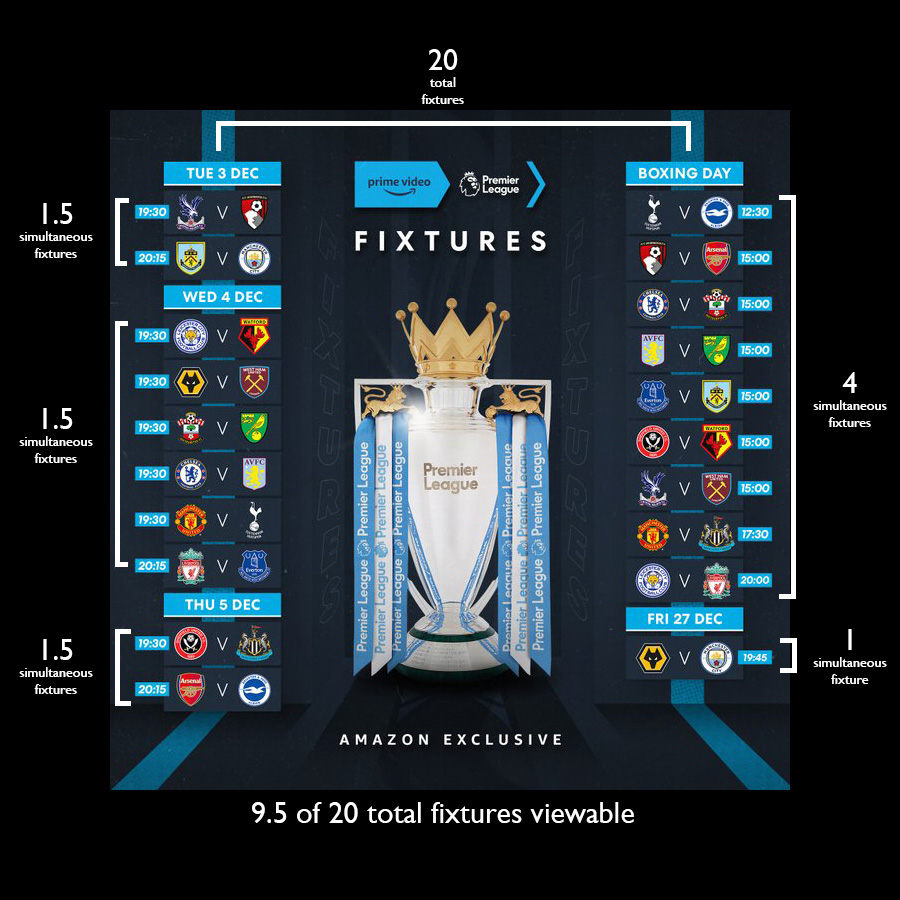
I’ve repeatedly tried to explain why the Premier League was foolish to package rights to every fixture across two of their Match Days as a single TV package when they sold their latest UK TV rights last year.
Amazon Prime ended up buying those packages after neither Sky nor BT felt they were worth buying. That’s because the existing TV partners just couldn’t get value from the twenty fixtures available.
Now that the Premier League fixtures for December have been published, I’ve annotated Amazon’s graphic [see above] to really demonstrate the issue.
When Sky buys a package of twenty fixtures, they normally get to monetise all twenty matches. That purchase buys them twenty weeks’ of football during a certain daypart. They can market the fact that they have football, say, at 4pm on Sundays. And viewers will know instinctively that the 4pm Sunday game is on Sky Sports.
Amazon doesn’t get that. Their twenty fixtures are over and done with in just five days. And even the most attentive viewer can only watch 9.5 of those 20 games. The other 10.5 games take place when that viewer is already watching another Premier League fixture.
More than half of the football that Amazon is showing cannot be watched live.
Amazon has worked hard to maximise their offering.
On Tuesday 3 December, they have two fixtures: Crystal Palace plays Bournemouth with a kick off at 7.30pm, while on the same evening, Burnley v Man City kicks off at 8.15pm. An assiduous viewer could watch the first half of the Palace game and then flick over the the Burnley game (or watch the whole of the Palace game and catch the second half at Burnley). So if that viewer doesn’t mind missing pre- or post- coverage, they can watch 1.5 live games that evening.
The scheduling allows for something similar on Wednesday 4 December, with a number of games kicking off at 7.30pm while the Merseyside derby starts at 8.15pm. So viewers of the earlier games could all catch the second half at Anfield.
And a similar pattern takes place on Thursday, when a couple of midweek games have been scheduled 45 minutes apart.
So Amazon has maxed out those 10 fixtures – having them over three nights rather than two, and keeping some fixtures as far apart from one another as they can. (I’m guessing the Premier League wouldn’t allow them schedule a UEFA-style split, with one game kicking off at 6pm and another at 8pm. There’d have been uproar from both home and travelling fans if they’d tried that.)
Boxing Day is more complicated. Nearly every team plays that day, with most kicking off at 3pm. But there’s an early game and two late games. So of the nine fixtures, a viewer with an acquiescent family could watch four of them as they worked their way through a plate of cold turkey. The tenth game runs unopposed on the 27th.
But this is all the reason why that Package F was such a duff offering and the Premier League struggled to sell it. Over five days, Amazon “owns” Premier League football. And then they’re done for a full year. They can hardly sell themselves as some kind of “home of football” or similar.
We’ve yet to see how Amazon markets these incidentally. I’d be amazed if they didn’t use them as a marketing ploy – perhaps making them free to everyone. Amazon released a glut of new hardware a couple of weeks ago, but new Fire TV sticks weren’t among them. Nonetheless, with Black Friday at the end of November, buying a cheap stick and getting the football included would seem like a good offer to make.
I guess we’ll see.
